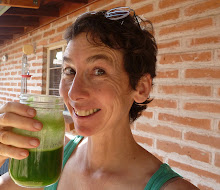Less than a year ago, I came across the word “blog” while reading on the internet. I didn’t know what that was, so I asked my friend, Thea, who worked at the MIIS Library with me. She didn’t know what a blog was either. Soon after, my friend, Kathy, emailed a link for a blog called “Sketchcrawl”. From there I found other artists’ blogs and wondered how I could put my artwork on the internet, too. Not too long after that, a friend in my TESOL program showed me her blog and another TESOL classmate showed me his blog. Ahh, so blogs were like journals that your friends could read, as well as being out there in public for anyone else to read. I wasn’t sure I’d like that part, but in June I decided to try it out.
I never expected blogging would be so interesting. Actually, my blog is pretty boring compared to many other blogs I read, and the few friends who comment usually email me directly rather than comment in the “public eye”. The blogs that interest me are ones about political happenings, art, science, and deep personal reflections, while I mostly talk about what I ate for lunch ☺.
Another unexpected pleasure of blogging has come via Flickr.com, the photo sharing web site. Originally, I joined Flickr in order to store my scanned in artwork (illustrations, drawings, paintings, pottery, etc) and display it on my blog site. At the time, Blogger.com did not offer a way to upload photos or graphics. In the meantime, I began to explore Flickr. I found people from all over the world using Flickr to store, display, and comment on their photos and illustrations in many languages.
I’ve been “meeting” people through Flickr who live in India, Japan, France, Spain, Portugal, Italy, China, Tibet, and other places. I read the comments that Japanese native speakers write to each other and to me, and I write comments in Japanese. This helps me improve and learn more Japanese. I have fun reading the Italian, French, Portuguese, and Spanish comments, and can struggle to get the gist of some of the Chinese comments. I can enjoy photos of India and other Himalayan region nations and read the regional English dialects of a whole diverse community of World English speakers. One of my Indian contacts wrote in her blog about a rural school in India whose students are using a digital camera for the first time and posting their photos and comments (in English) on Flickr. I got excited thinking of the potential international contacts and interaction one can have in the ESL/EFL classroom. My (future) students can post their journals, photos, and drawings on personal or classroom blog sites while interacting with others via English, and learning about others’ cultures.
There’s been a scary thing, too. A person on Flickr from the United Arab Emirates using the moniker “UAE Kidnapper” listed me as one of his contacts. I went to see who that was and found comments I don’t understand because the Arabic writing doesn’t appear on my computer, only gobbledy gook. I don’t read Arabic, but at least if the script appeared as actual Arabic, it would seem less like gang tags.
Investigating further, I saw that several members had the same or a similar icon of a man wearing a long white cloth on his head encircled by a black ring. In his photostream, UAE Kidnapper had photos of UAE money, swords, guns, fancy cars, buildings, and men in flowing robes sitting together in what appeared to be a political assembly of some sort. I saw that one of the people who commented on “Kidnapper’s” photostream had a Hitler icon.
I have known people from the UAE before. I tutored English for the TOEFL exam to several UAE students a few years ago in Tucson. Yes, our cultures are very different, but they weren’t scary; they were very young students, 20 or 21 years of age, and friendly.
I can’t imagine wanting a moniker like “UAE Kidnapper”. It doesn’t feel very inviting….
In the end, I didn’t mark UAE Kidnapper as my contact. But I do wonder, why would someone want to be known as "UAE Kidnapper"? Why would someone want to use a Hitler icon? I don’t get it.
Here are some of the very interesting (damn interesting) blog sites I read. My favorites are the blogs from India or are written by Indians living outside of India. Reading these intelligent, personal, and lively writings, I am inspired even more to go to India someday.
"Indianwriting" by Uma in Mumbai.
“A Time to Reflect” written by Charukesi who lives in Bombay (Mumbai) aka “Road Blog” on Flickr.
“All Over the Map” written by a Canadian living/working in New Delhi, India, aka Eileen_Delhi on Flickr.
"Citybytes" written by a young student, Zainab Bawa, in Mumbai, who writes on public spaces.
"Balancing Life" by Sunil Laxman, an Indian living in Seattle.
"Locana" by Anand from Bombay, Maharashtra, India.
“Shallow Thoughts to Profound Insights” by Sowmya in the US.
"Trivial Matters" by Akshay, a young computer science student in India.
George Johnson's "Between Seeing" post on using Mind Maps, via Charu.
Siddharth Varadarajan, New Delhi, India, journalist and deputy editor for The Hindu
Other favorite blogs:
Keri Smith's "Wish Jar Journal"
Trevor Romain's "Trevor’s Blog"
Danny Gregory's "Everyday Matters"
"Sketch Crawl'
Monday, September 26, 2005
Thursday, September 22, 2005
Fan mail
Today I received fan mail from my friend Hyejung. Here it is:

The message was written on the back of a fan which was inside the card. Hyejung also enclosed a few photos taken in Monterey in late May. From my current location in hot Tucson, it's hard to believe jackets and pants were necessary... Ahh~coolness!
* * * * * * *
These two photos show Anna, Nicole, and Hyejung infront of the MIIS president's office near the library where we three worked.

Next, we have Anna, Nicole, and friend Shirley from Santa Cruz.


Anyanghikaseyo!

The message was written on the back of a fan which was inside the card. Hyejung also enclosed a few photos taken in Monterey in late May. From my current location in hot Tucson, it's hard to believe jackets and pants were necessary... Ahh~coolness!
* * * * * * *
These two photos show Anna, Nicole, and Hyejung infront of the MIIS president's office near the library where we three worked.

Next, we have Anna, Nicole, and friend Shirley from Santa Cruz.


Anyanghikaseyo!
Wednesday, September 21, 2005
what i ate today

My first meal today was lunch. I ate an open face melted brie sandwich on toasted caraway rye bread with stone ground mustard, red onion, fresh basil, and heirloom tomatoes; a bowl of steamed Chinese brocolli with apple cider vinegar & olive oil; an avocado half sprinkled with soy sauce; and yummy matcha iri genmaicha (green tea) direct from Japan via my friend Chi.
After lunch I ate a few small squares of organic dark chocolate and a nectarine.

For dinner I ate Thai Kitchen brand instant noodles that take 3 minutes to cook, chile & lime flavor. I added sliced shiitake mushrooms, tofu cubes, green onion, and a few fresh basil leaves for a yummy, simple meal.
**Oh--and I didn't eat the fly that's sitting on one of the bottom tomato slices.
Tuesday, September 20, 2005
Thursday, September 15, 2005
Bo-cha and potatoes
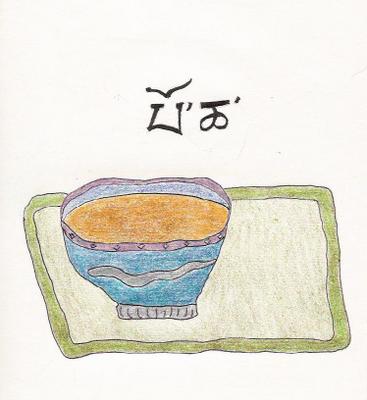
I made yak butter tea today (bo-cha). I used our ‘regular’ cow butter instead of yak butter since it is not available in the Sonoran desert. I made the tea with pu-erh tea, adding it to boiling water for a few minutes. The next step, if I were being authentic about making bo-cha, would be to strain the tea and pour it into the tall, wooden, cylindrical butter churn used by Tibetans just for bo-cha (called a chandong).
My next step, was to pour the boiling hot strained tea into an electric blender. In went a little sea salt, some butter, and half and half. I ‘churned’ it all up in a few seconds. I drank a few bowls of bo-cha with my lunch of purple, yellow and red potatoes sautéed in olive oil with green pepper, yellow onion, cabbage, garlic, pepper, oregano, and salt. Yum. The tea was very satisfying—and rich.
Over the past several months especially, I have read many books and articles on Tibet and Tibetan culture and have watched some of my favorite movies about Tibet over and over again. Last night, I continued reading the book Beyond the Sky and the Earth: A Journey Into Bhutan written by a young Canadian woman who went to Bhutan to teach English. In the part I was reading before bed, she was eating a Bhutanese potato dish in the home of a fellow teacher. Before I fell asleep, I knew I would make some pretend Bhutanese potatoes for my main meal today, too. The potatoes were real, they just weren’t Bhutanese—like the lack of yak butter in my yak butter tea. But, with the good imagination that I possess, I was enjoying real bo-cha and eating real Bhutan style potatoes.
Cooking and eating foods from books and movies is also a fun thing to do with reading classes and with students of all ages in language classes. Edible enactments create new ways to engage learners with the story, their imaginations, tools, language, and with each other.
* * * * * * *
Tomorrow, Friday, the 16th of September, is day one of the "Tucson Teachings" given by His Holiness the Dalai Lama. I’m sure HH (His Holiness) has already arrived in Tucson and is here now.
I will be listening to the daily live broadcasts of his teachings on Chapter 8 of Shantideva’s The Guide to the Bodhisattva’s Way of Life.
HH's teachings are available free to anyone with a high-speed internet connection and iTunes or WinAmp (these can be easily downloaded from the LamRim radio site given above). The teachings will be broadcast from 10am to 12pm and 2pm to 4pm (MST) Friday, Saturday, and Sunday, the 16th, 17th, and 18th of September. HH gives his teachings in Tibetan while a professional interpreter gives the English version consecutively. Sometimes, HH may speak a little English to add to or clarify a point.
I find HH’s laughter alone is worth listening to the talks.
* * * * * * *
On another entirely different topic, I woke with a happy, light feeling this morning.
Jesse was curled up on top of the sheet and was nestled into my side. I had a song in my mind to the tune of This Little Light of Mine (I’m Gonna Let it Shine):
This little cat of mine/I love her all the time
This little cat of mine/I love her all the time….
As I cooked my potatoes and moved around the house I sang this song and also the original.
This little light of mine/I’m gonna let it shine
This little light of mine/I’m gonna let it shine….
This little cat of mine/I love her all the time
All the time/all the time/all the time.
* * * * * * *
P.S.
The script above my illustration is my attempt at writing the Tibetan word for butter tea, bo-cha. It may not be accurate. I consulted a Tibetan language site to write it.
Tuesday, September 13, 2005
Coffee?
Sunday, September 11, 2005
Japan!

Twenty years ago today, on September 11, 1985, I landed at Narita Airport with my bicycle and my bicycle partner, Kate. We had been bicycling since April. We left our home in Flagstaff, Arizona in an unexpected April blizzard, with just our bicycles, equipped with panniers, camping gear, a small stove, some food, minimal clothing (including rain gear), and bicycle repair tools. We also carried journals, a couple of books each, and a small Olympus 35mm camera.
Our first night out, April 25th, 1985, we camped on the Navajo reservation near the vermillion cliffs in Northern Arizona. Our second night, further north on the rez, a young Navajo man climbed down to the flat ledge where we were camped in our little yellow tent in a small redrock canyon. He'd seen the glow of our candle-lantern illuminating the tent inside and wondered what it was. His grandmother told him to check us out. "We thought you were aliens," he said. In the morning after cooking our breakfast, we were washing out the pot and packing up. We saw the grandmother sitting on the ledge watching us from above.
From Northern Arizona, we cycled through Utah, Idaho, Montana, Washington, British Columbia and Yukon, Canada, then into Alaska. Part of the way we took a ferry. From Seattle, we ferried to Juneau to visit a Tlingit friend and then on to Haines, Alaska. On the ferry, other adventurers slept on the deck in their self-standing dome tents. Our little tent needed pegs, so we slept inside, between the rows of chairs on the main deck. From Haines, Alaska, we rode through BC and Yukon, Canada, and back into Alaska. Starting somewhere along the Salmon River in Idaho we occasionally hung our food at night as a protection against bears. In the mountains and forests of Washington, as well as in Alaska and Canada, we hung our food every night. At campgrounds, large steel "bear lockers" were provided. We put anything that smelled edible or remotely edible to a bear inside the lockers: toothpaste, soap, water bottles, cook pot, eating utensils, all food, chapstick, anything.
We cycled north of Fairbanks and then headed south towards Denali National Park. We stayed about five weeks in the park, camping at the campground. At night, we washed the school buses that took tourists through the park. The 97-mile road out to Wonder Lake was unpaved and dusty, so the buses needed to be washed each night. It seemed like there were a hundred buses to wash every night. Our job was to use high power water hoses on the outside, then to clean and dry the inside and outside, with special attention to cleaning the windows. We worked as efficient teams of about 5 or 6 to a bus. Work usually began at around 8pm and ended at 2 or 3am in the twilight hours when the sky was a turquoise color. We made $13/hour and saved almost 100% of it for our onward journey. We paid no rent--our home was our tent inside the backpackers' and bicyclers camp at Denali--and we cooked all our food. During the days, we hiked, read, relaxed, wrote in our journals, and took short bicycle rides without our gear.
Back in Flag(staff), we had prepared packages of travel food for Alaska/Canada: mixtures of whole grains and beans cracked up in the blender for quicker cooking, oatmeal and bulghur wheat for breakfasts, miso paste, natural ramen, soy jerkey, seaweeds, herbs, vegetable bouillon cubes, dried fruit, chocolate-mint soy milk, ground coffee, dried milk, and lots of granola bars. We mailed boxes of our travel food to five different post offices throughout Alaska.
We used our bus washing earnings to buy our one-way plane tickets to Japan from Anchorage, with onward passage to Hong Kong. We stayed with friends in Anchorage while waiting for our Japan visas. I bought a book, Japanese in 10-Minutes a Day, which included several pages full of stickers of vocabulary words in romaji (roman letters--Japanese words transliterated into our alphabet letters). I had fun putting stickers on objects all over my friends' house and beginning the process of learning Japanese.
Ten days later, we had landed in Japan with our bicycles in boxes. It was late when we arrived and we were too tired to put our bikes back together after we landed. That first night, we took turns sleeping sitting up in the airport and being told to move every couple of hours by the guards. In the morning we dragged our boxes outside and put our bikes back together. I could say jitensha with confidence, so that's what I'd say whenever anyone spoke to us. Jitensha means bicycle. Since I was the language expert (ha-ha) I was in charge of deciphering any signs, maps and oral communication. Well, I was already literate in French and Spanish, had studied some Chinese, knew some prayers and songs in Hebrew, and felt confident that I knew how to learn languages. Kate had happily given up teaching to become a massage therapist, but she also had a Master's degree in teaching ESL from NAU. Kate would likely be the first one of us to obtain employment when it became necessary to do so. At that point, I had worked doing unskilled labor in a printing bindery; had been a camp counselor; had cashiered and handled ordering in a natural foods store; did everything in a whole foods bakery; was a barrista at a café; tutored Spanish, English, and French; did occasional illustration/art jobs; had cleaned houses; worked in a deli; worked at a plant nursery; and took care of children. I had taken about two years of university classes, had no degree, and had never written a resumé. However, In the end we both got jobs teaching English.
* * * * * * * *
Riding a bicycle is a good way to see a place. Most visiting travellers to Japan get off the plane, go through customs, and head for a hotel, hostel, or ryokan. They go by private car, taxi, bus, subway, train, or any combination of these. We got on our bikes and started pedalling out of the airport complex with its nauseating jet fuel fumes, in search of a place to rest in Narita-shi. We rode on the 'other' side of the street than we were accustomed to riding. There were green bamboo trees at the edge of the airport.
In Narita-shi we found a small family run inn. We stayed a few nights to restore our sleep pattern and because we liked the family and Narita-shi. We found ourselves on the second day at a goma 'fire' ceremony performed by Buddhist priests in the main temple at Narita. The temple complex there, Narita-san shinshoji temple and park, is an important pilgrimage place for millions of Buddhist pilgrims in Japan.
Soon we were being ushered in with the crowds. A man told me in English that we should offer something to the fire. All I had with me was my little pocket size Japanese phrase book that I was studying and my passport. So I gave the man both. The priest passed both over the fire and they made their way back into my possession.
I partially credit that goma ceremony for allowing me to get several extensions on my tourist visa plus a change from a tourist visa to a cultural visa without having to leave the country, without even having to go to the Osaka Immigration Office (from Kyoto)--unheard of among all the other English teaching gaijin I knew living in Kyoto. I also credit that I wrote a letter to the immigration officials entirely in Japanese telling them why I wished to stay in Japan (to learn more about the language & culture).
September 11th--the date means different things to different people. For me, I always remember September 11th (1985) as the beginning of some kind of deep learning that continues to this day.
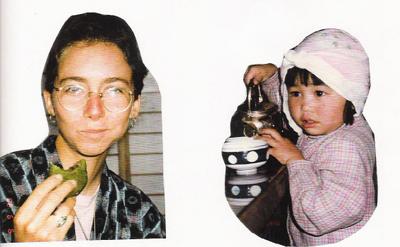
That's me on the left at the inn in Narita-shi eating my favorite Japanese sweet, yomogi genmai mochi with sweet red bean paste in the middle. Yomogi is 'mugwort', a green herb that gives it the color (and is very healthy) and genmai mochi is pounded glutinous brown rice.
On the right, is little Mai-chan, daughter of the inn keepers, three years old, wearing a towel on her head. She adored Kate and followed Kate around everywhere, wearing a towel on her head because Kate wore a bandana on her head.

Here, I am in Sapporo, trying on a wedding kimono at the kimono rental shop of the mother of my friend Yoko's brother's best friend.
Tuesday, September 06, 2005
A ride through town
In the late afternoon today I rode down to epic café to be around people and have some tea. I'd gotten a letter in the mail from a friend and brought that with me to read over tea. I snapped some photos as I made my way to epic. After hanging out a while and reading and chatting with a couple of café friends, I rode over to Chi & Rodd's place to see if Chi was home. It was now about 6:30. Chi was just heading out to epic on her bicycle, so back I went. We talked for about three hours, then I rode home in the cool dark Tucson night (my temperature widget says it is 88ºF/31.1ºC).
There is a stretch of road somewhere between the Campbell & Prince intersection and the Prince/Tucson Blvd intersection, that always smells sweetly of hay and horse manure on my ride home. It's quiet in the rillito area at night, and dark. When the sky is clear, I cannot help but look up at the zillions of stars--even while riding my bike. Tonight there were long stretchy clouds and the faintest sliver of a waxing crescent moon in the west.
Here are some photos from my journey today.

These cacti are growing along the bike path. Prickly pear, cholla, a baby saguaro, and a mesquite tree.

The lizard and prickly pear decorate an adobe wall surrounding a house.
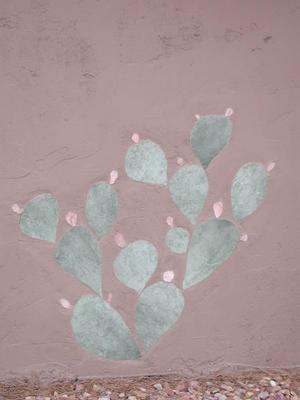
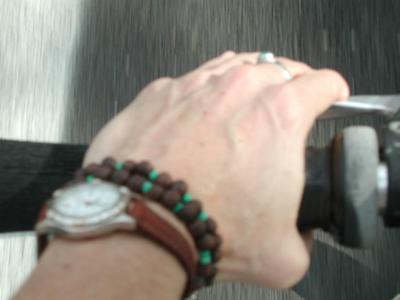
I took this while riding. The camera was in my right hand.

There are still many fruit on these prickly pear that grow beside the bike path.

This entry way is in front of a house in the Sam Hughes neighborhood.
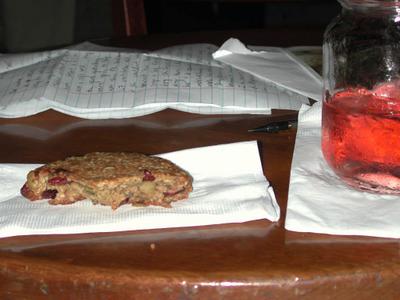
It's a rare pleasure to read a paper letter these days. That's my table at epic with the hibiscus tea I drank, the seed cookie I ate, and the handwritten letter I read.
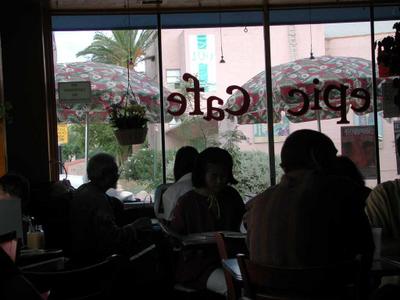
The scene tonight at epic café -- around 6pm.

On my way to Chi's, I asked this man if I could take his picture. He is from the art gallery/tatoo shop down the street from epic on 4th Av.

Heading west now, the sky looked like this for a moment. Then it changed.
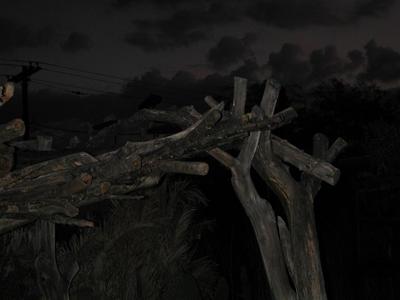
This is a top corner of the ramada which protect the many bicycles at the Lancaster household.

The rooster in the Lancaster yard with the tiny crescent moon above it.
There is a stretch of road somewhere between the Campbell & Prince intersection and the Prince/Tucson Blvd intersection, that always smells sweetly of hay and horse manure on my ride home. It's quiet in the rillito area at night, and dark. When the sky is clear, I cannot help but look up at the zillions of stars--even while riding my bike. Tonight there were long stretchy clouds and the faintest sliver of a waxing crescent moon in the west.
Here are some photos from my journey today.

These cacti are growing along the bike path. Prickly pear, cholla, a baby saguaro, and a mesquite tree.

The lizard and prickly pear decorate an adobe wall surrounding a house.


I took this while riding. The camera was in my right hand.

There are still many fruit on these prickly pear that grow beside the bike path.

This entry way is in front of a house in the Sam Hughes neighborhood.

It's a rare pleasure to read a paper letter these days. That's my table at epic with the hibiscus tea I drank, the seed cookie I ate, and the handwritten letter I read.

The scene tonight at epic café -- around 6pm.

On my way to Chi's, I asked this man if I could take his picture. He is from the art gallery/tatoo shop down the street from epic on 4th Av.

Heading west now, the sky looked like this for a moment. Then it changed.

This is a top corner of the ramada which protect the many bicycles at the Lancaster household.

The rooster in the Lancaster yard with the tiny crescent moon above it.
Thursday, September 01, 2005
What we're eating

Nicole: rice with black sesame seeds and an umeboshi; miso soup with wakame seaweed, green onions, and a few drops of toasted sesame oil; bowl of steamed Lacinto kale & red chard with oilive oil and apple cider vinegar; chilled slices of tofu drizzled with soy sauce and freshly grated ginger; sencha green tea.
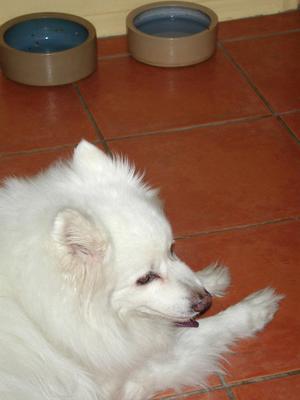
Yuki: lamb & rice dry dog food with two spoonfuls of moist lamb & rice; water.
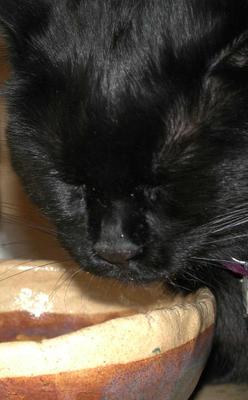
Jesse: ocean fish & salmon canned cat food with dried salmon cat food. Yum yum.

Hummingbird: Five-to-one mix of water & white granulated sugar; nectar from assorted native plants.
What we're reading

Here are some sample verses from Cold Mountain:
* * * * *
209
When water is so clear it sparkles
you can see the bottom without effort
when your mind doesn't have a goal
no circumstance can distract you
once your mind doesn't chase illusions
even a kalpa holds no changes
if you can be so aware
from such awareness nothing hides
* * * * *
210
Talking about food won't make you full
talking about clothes won't make you warm
only eating food will make you full
only wearing clothes will make you warm
people who don't know how to reason
just say a buddha is hard to find
look inside your mind there's the buddha
don't look around outside
* * * * *
224
I enjoy the simple path
between dark vines and mountain caves
the wilderness has room to roam
with white clouds for companions
there's a road but not to town
only mindless men can climb
at night I sit on the rocks alone
until the moon comes up Cold Mountain
(The Collected Songs of Cold Mountain 寒山詩
Translated by Red Pine, Copper Canyon Press, 2000).
* * * * *
This is a bilingual version, with the original Chinese on one page and Red Pine's English translation on the facing page.
The person known as Cold Mountain (Han-Shan; 寒山) named himself after the cave he chose to live in. Based on written artifacts he examined while researching this book, Red Pine places Cold Mountain between 730-850, during the Tang Dynasty. Cold Mountain lived and wrote his poems/songs (詩) in present-day Chekiang Province at the base of Hanyen, on Cold Cliff, a two-day walk from the East China Sea (p. 4).
Subscribe to:
Comments (Atom)


